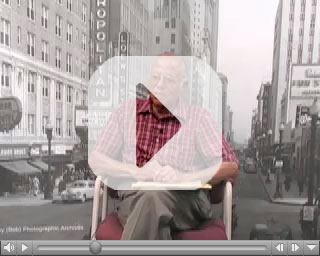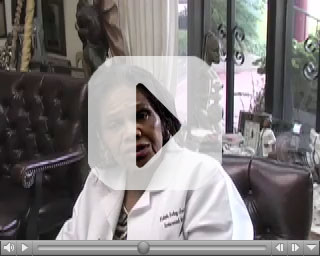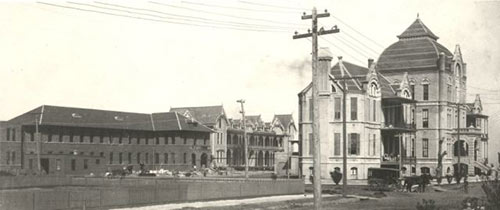The Negro Health Problem (1900-1926, Section 5)
1915
The increased emphasis on standardized medical education as a requirement for licensure improved the overall quality of medical care across the country, but all Americans did not benefit equally. African Americans remained an underserved segment of the nation’s population and faced persistent health risks as a result of segregation. “Certainly greater than two-thirds of the 20th century medicine was segregated in the city of Houston” points out Dr. L. Natalie Carroll. 1
Houston’s Dr. Henry E. Lee addressed these issues in “The Negro Health Problem.” The Red Book of Houston featured his essay. Jim Crow segregation had limited economic and housing options for most African Americans. Dr. Lee described the houses in which most black Houstonians lived as “death traps” where “every condition conducive to the origination and the spread of those diseases which develop and thrive under such unsanitary conditions” existed. 2
Consequently, African Americans were more susceptible to diseases, such as tuberculosis, typhoid fever, cholera, or typhus, associated with poor sanitation.
Typhoid fever, for example, is an infectious disease caused by ingesting contaminated water or food. Tuberculosis is a contagious infection caused by bacteria. Both diseases have appeared more frequently among poor patients who live and work in unsanitary conditions. In the early 1900s, African Americans were disproportionately represented among the nation’s poor and thus, faced greater susceptibility to these diseases.
By the 1920s scientists had isolated the causes of typhoid and tuberculosis, identified treatments, and developed preventive measures, primarily in the form of vaccines. Nonetheless, both diseases still proved deadly for many African-American patients who had limited access to those preventive measures or to health care facilities and who struggled to improve sanitary conditions in the face of poverty and discrimination.
Segregated Health Care
Native Houstonian Emmett J. Scott, who spent several years as an executive secretary to Booker T. Washington and later served as an assistant to the U.S. Secretary of War during World War I, wrote for the Houston Post and authored a number of books. In 1915, the Red Book of Houston featured his article, “Efficiency,” in which Mr. Scott argued that poor educational opportunities and the health conditions undermined African-American communities across the country. Scott concluded that perhaps 45 percent of an estimated 800 deaths of black Houstonians in 1914, for example, were preventable. 3
In the early twentieth century, few Houston hospitals admitted African-American patients. Many white physicians refused to see them at their offices, and those who did enforced Jim Crow segregation, often forcing African-Americans to wait in separate rooms or to enter through separate doors. Summing up this care, Dr. Gladys Forde (daughter of Dr. George Patrick Alonzo Forde) noted “some white physicians treated black patients, and not very respectfully.” 4 Not surprisingly, many black patients avoided those doctors. Additionally, physicians often charged fees beyond the means of many poor Houstonians – both white and black. Consequently, they relied on home remedies and patent medicines to cure their ailments, turning to physicians only for the most serious health crises.
Patent medicines versus preventing disease
Patent medicines claimed to cure multiple ailments, and usually contained narcotics which provided relief, albeit temporarily and often with dire consequences. People purchased patent medicines at pharmacies or from traveling medicine shows that remained popular until the 1930s when the Great Depression and greater government regulation of food and medicine combined to cause their demise. While subsequent federal laws proved more restrictive about what products could be labeled “medicine,” the first Food and Drug Act in 1906 only required that labels list addictive ingredients.
Concerned about the availability of these patent medicines and the underlying health issues in his community, Dr. Henry E. Lee appealed to preachers, teachers and other community leaders to educate the black Houstonians on “how to preserve their health” and therefore to improve conditions for their race by working together to combat preventable diseases.
He urged African Americans to “wage a war and to continue to fight” typhoid, tuberculosis, and venereal diseases until the death rates were reduced. 5
Educating the public only addressed part of the problem, however. Houston needed more physicians to care for its growing African American population and more hospital facilities willing to accept black patients. Before 1919, Houston hospitals only employed white physicians. Many refused to admit black patients, and the few that did, reserved only a small number of beds in charity wards separated from white patients.
When they needed hospitalization, most black Houstonians traveled to the segregated Negro Hospital at the University of Texas Medical Branch at Galveston, some 40 miles southeast of Houston. Unknown numbers perhaps died because of the lack of more proximate facilities.
Houstonians relied on the handful of African-American physicians to visit to their homes in emergencies.
Despite those physicians’ heroic efforts, the health of black Houstonians was jeopardized by poor sanitation, inadequate diet, and their inability to get consistent care.
Citations
- Dr. L. Natalie Carroll, Interview by Yimei Zhang, March 29, 2005, tape recording.
- H.E. Lee, “Negro Health Problem,” in The Red Book of Houston: A Compendium of Social, Professional, Religious, Educational, and Industrial Interest of Houston’s Colored Population (Houston, Texas: Sotex Publishers, 1915).
- Emmett J. Scott, “Efficiency,” in The Red Book of Houston: A Compendium of Social, Professional, Religious, Educational, and Industrial Interest of Houston’s Colored Population (Houston, Texas: Sotex Publishers, 1915).
- Dr. Gladys Forde, Interview by Leigh Cutler, March 14, 2005, tape recording.
- Lee, “Negro Health Problem,”.







